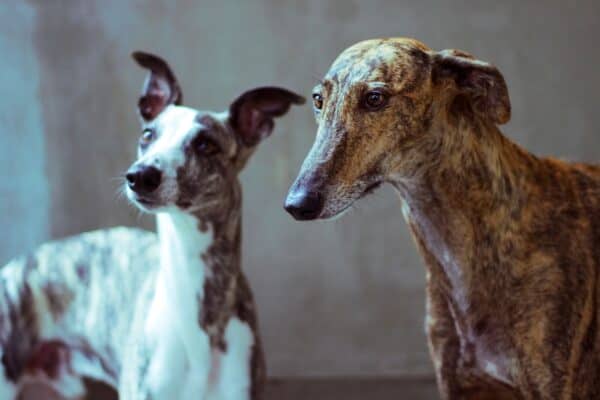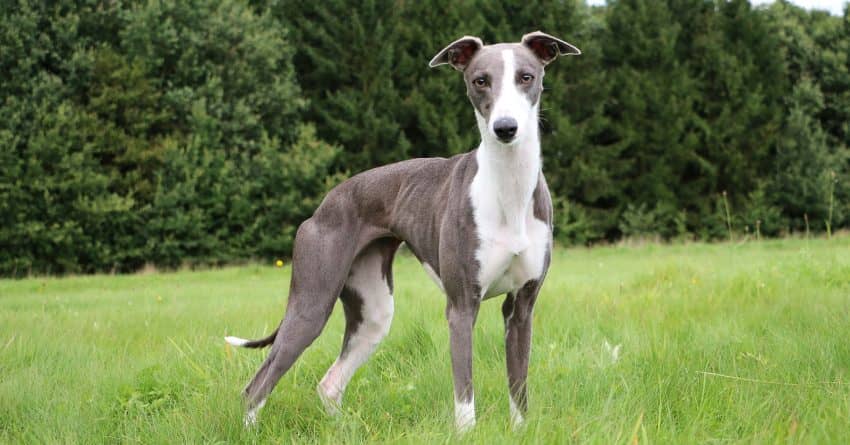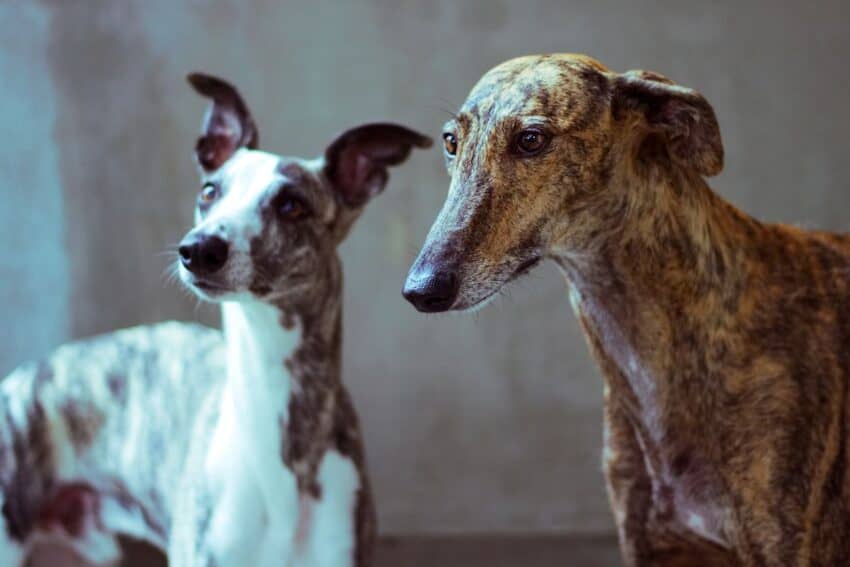Whippets and Greyhounds are both wonderful dog breeds that commonly get confused with each other. It’s easy to understand as they share many characteristics. But once you get into the details, their differences become more evident.
The first thing to understand is both are adaptable to many situations. I can’t imagine anyone reading this article won’t love owning either of them. However, understanding the differences is essential when deciding whether these breeds are a suitable option. So let’s dive into these differences and see if a Whippet or Greyhound is a better fit.

Differences Between Whippets and Greyhounds
It may be hard to believe, but Whippets and Greyhounds differ in several ways. I’ve narrowed it down to seven categories where there are a few differences between them: size/appearance, temperament, history, grooming, health, diet, and exercise requirements. Understanding these distinctions will provide a solid idea of what caring for them requires.
1. Size
The easiest way to tell Whippets and Greyhounds apart is a size comparison. For instance, Greyhounds are a much taller breed, measuring up to 30 inches. Whippets only measure up to about 22 inches at their maximum height.
As you can imagine, this size difference reflects itself in their respective weights. Whippets often weigh anywhere between 25 and 40 pounds. Greyhounds have much more bulk to their builds, weighing between 65 and 70 pounds.
If these height and weight differences didn’t exist, it’d be impossible to tell them apart. Both breeds share many other appearance traits from each other, including a narrow/long muzzle, skinny builds, broad/deep chests, arched backs, and a whip tail type.
It’s got to the point where people even describe Whippets as “miniature Greyhounds.” On several occasions, I’ve even made the mistake of switching them in mind, thinking Greyhounds were smaller and Whippets were larger.

2. Temperament
Whippets and Greyhounds aren’t too different temperament-wise. Most experts agree that the breeds are non-aggressive, intelligent, and sociable dogs. But there are a few differences in their respective make-ups.
For instance, Whippets are prone to picking up separation anxiety. So they form overly dependent bonds with their owners. If left alone for long periods, it can make them destructive within a home (torn apart furniture and barking are typical results).
It’s also worth noting Whippets prefer staying inside more than a Greyhound. These dogs have no issue being couch potatoes for large portions of the day. However, they still enjoy their time outside and require significant exercise daily (more on this later).
Another difference is Greyhounds are often easier to train. It’s why this breed has been used as race dogs for centuries. But it’s not like Whippets are these untrainable nightmares, though. Any competent owner will have no trouble teaching them basic commands.
One last notable temperament difference is Whippets are more sensitive. They are easily startled by encountering unexpected things or objects. For instance, someone petting them without them noticing can result in them jumping.

3. History
History is one area where these two breeds differ considerably. After all, Greyhounds have a rich and detailed background going all the way back to ancient Egyptian times. These dogs even get a mention in the Bible.
Whippets can’t compete as they’re only a few hundred years old. In fact, they’re considered descendants of Greyhounds. The breed popped up when people were mixing Greyhounds with long-legged Terriers during the 18th century. Most experts pinpoint their origin to Northern England, where people used them to hunt small prey like rabbits.
Overall, they’re a relatively young type of dog compared to the Greyhound. But it hasn’t stopped their popularity from rising these last few decades. You’ll find Whippets all over the world as you would Greyhounds.
4. Grooming
Grooming isn’t a massive problem area for either breed. Both Greyhounds and Whippets have short coats that don’t require much maintenance. As a result, they would benefit from wearing a jacket during the colder months.
This short coat also comes with thin skin that doesn’t protect them much outdoors. Due to this, it’s not uncommon to find short cuts or scrapes on either breed after an outdoor activity. So you must do regular checks to ensure they can address these issues immediately.
As for the difference in their grooming requirements, it comes with the shedding level. Whippets shed less than a Greyhound, so they don’t require as much brushing. I’d still brush them once a week, but a Greyhound might need them twice a week during shedding season.
In either case, a soft bristle brush should get the job done without much issue. It should be more than enough to keep the coats in excellent shape.
5. Health
Whippets have a reputation for being healthier than their Greyhound counterparts. It’s a reality that is reflected in their respective life expectancies: Whippets often live between 12 and 15 years, while Greyhounds will end up living 10 to 12 years.
But this healthier reputation doesn’t mean Whippets don’t have problematic health issues. This breed is known for having eye issues, deafness, and Willebrand’s Disease. Anyone who considers getting one should do whatever possible to prevent them.
Greyhounds aren’t overly known to have an overwhelming number of health issues. However, owners should be aware of hypothyroidism, hip dysplasia, and bone cancer. These conditions have shown a habit of making a Greyhound’s life much more unpleasant and difficult.
I should also note that these breeds share an anesthesia sensitivity. Surgeries can be more problematic and worrisome than with other dogs. It’s best to talk with the vet about these concerns if your Whippet or Greyhound does need to go under the knife.
Dental health issues are another shared concern for both breeds. I’d suggest brushing their teeth weekly to help prevent any issues. But remember, the toothpaste and toothbrush need to be made specifically for dogs.
6. Diet
A well-balanced diet is pivotal to keeping any breed healthy and happy. Whippets and Greyhounds aren’t any different with their varying nutritional needs. The difference is the latter will need more food than the former.
Most experts consider 3 to 4 cups of food daily for Greyhounds. Their larger size will need it to keep energy levels up each day. Most owners should stick to 2 or 3 cups per day for Whippets because of their smaller size.
These guidelines should prevent obesity from being an issue. Sadly, obesity has a massive impact on both breeds with their frail frames. It puts severe stress on their bones, which can cause joint discomfort.
If you aren’t sure about their diets, check with your vet. It’s what I do when I get a pup who’s breed requirements aren’t too familiar. Any quality vet will provide a stringent diet plan to follow. It’ll then ensure your Whippet or Greyhound lives as long as possible.
7. Exercise Requirements
Both breeds are known for being among the fastest in the entire world. However, it doesn’t mean that their exercise needs are extensive. I’d even venture to say their requirements don’t even fall among the top tier. Instead, owners should expect to provide about two long walks daily to keep them entertained.
But it’s worth noting Greyhounds do require a bit more mental stimulation. Most owners find puzzle games or more involved training to be effective at keeping their brains engaged. Otherwise, they will find other ways to entertain themselves.
Trust me; their methods aren’t ones anyone in your household will enjoy. It’ll often result in them doing zoomies around the house or chewing whatever they can find. But if you meet these needs, you won’t find a better couch potato than a Greyhound or Whippet.
What’s The Best Home For Each Breed?
After this talk about the Whippets Vs. Greyhounds, I thought it’d be wise to identify what homes would best mesh with each breed. It’ll be a final piece to the puzzle of whether a Whippet, Greyhound, or neither is a fit for your household.
Best Homes for Whippets
Whippets function best in a home where their owners are around all the time. I’d imagine these dogs would be excellent fits for people who work at home or a family. In these situations, a Whippet wouldn’t ever feel alone or bored.
I’d also recommend Whippets to any owner who loves outdoor activities. These dogs love going on walks and enjoying what mother nature has to offer. But please, keep them on a leash as they’re prone to chase any smaller animal.
Therefore, a potential owner with cats shouldn’t consider Whippets. Multiple friends have told me that teaching them not to chase felines is a nightmare. I couldn’t even manage the struggle for first-time dog parents.
Best Homes for Greyhounds
Greyhounds are perfect for owners with large yards where they can stretch their legs. These dogs can function in multi-dog households and work great with families. You won’t find many breeds better with kids than a Greyhound.
But Greyhounds do require an owner who will commit to their exercise needs. These dogs require multiple long walks daily to help deal with their energy levels. So it’s vital to plan how to keep them entertained: hiring a dog walker is never a bad idea.
Lastly, Greyhounds don’t get along with cats or other small non-canine pets. I would never suggest one to a family with these animals. As with Whippets, it’s a disaster due to their chasing tendencies.
Conclusion
Since you now understand all the key differences, it’s time to choose between a Whippet and a Greyhound. It shouldn’t be difficult to select the best option with all this new information. It’s all about looking at the subtle contrasts and thinking about how it would impact your household.
For instance, a Greyhound’s larger build could be a problem in a small apartment. But a Whippet’s need for attention is an issue for people who aren’t around constantly. Accounting for these little details will help decide the debate of Whippets Vs. Greyhounds. Honestly, it may be apparent that neither is a good fit (hello, cat owners).
Let me know what you decide in the comment section. I’d also love to continue discussing these amazing dog breeds for anyone with more questions or stories about owning them. Thanks for reading!
Author
-

My name is Ben Roberts, and I’ve been writing about animals for many years. Honestly, I couldn’t ask for a much better job, considering I’ve been around animals all my life. I can’t remember a time when there wasn’t at least one cat or dog inside my home. Currently, I’m a proud owner of a Beagle and a Pitbull who make sure my life is never dull.
View all posts



